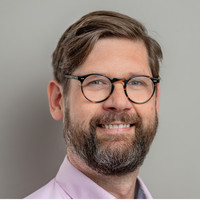Energy Technology wants to attract women with role models
How is the JML work going, Björn Laumert?
At the Department of Energy Technology (EGI), 40% of the students are women, but in the faculty's Tenure Track*, 100% are men. "We have obviously failed to attract important talents," says Head of department Björn Laumert, who is now investing heavily in JML in the department's management team.
If you sneak into a classroom at the Department of Energy Technology, there is basically a man in every other chair and a woman in every other, but at the whiteboards, the female teachers are conspicuous by their absence. For the Head of Department, Björn Laumert , the image of the classroom became an eye-opener that started several processes.

"It is clear that we did not work well enough with these issues", says Björn. "We have let the women go to industrial companies or other universities without doing anything about it, and lost a lot of talent".
"In addition, we get feedback from our employees that there is a work culture with unequal treatment at work – often because of gender and sometimes because of nationality or age. I find this very problematic".
The Department of Energy Technology (EGI) is not the only one with these kinds of issues. It is a general challenge that women opt-out of research careers, but EGI wants to do something about it. Today, the entire management team is involved in the JML work because, according to Björn, the managers with personnel and recruitment responsibilities can do something about the problems.
The department is now working in three specific areas: Current situation analysis, female role models and recruitment strategies.
Mahrokh Samavati , JML Manager at EGI, has conducted interviews with all women within the faculty and the same number of men about how they experience the work environment from a JML perspective. The management team has already discussed some answers, and the final report is expected later this year.
Even though EGI has 40% female students, it is obviously difficult to make them stay, doctorate and develop in the tenure track. When positions like assistant professors and professors are assigned, managers at the department can no longer influence which candidate gets the job; the eligibility requirements and the Employment Board decide. But on the way there, the boss has a crucial role.
"We see that it is important to work consciously all the way from selecting people to specific degree projects, how we nurture them during the doctoral studies and encourage and enable a continued academic career. We have already identified a number of female talents that we are actively working with so that they can become well-qualified aspirants for higher titles".
In addition to giving women from within EGI a greater opportunity for higher merit points, they strive to get talented people from outside to apply for positions. As a researcher, one needs to put the most energy into the career at the age of 25-35, i.e. at the same time as many start a family. This in itself can make many women opt out of that path, says Björn. Here they can become better at attracting women.
"The competition for talented people is tough, and we are constantly refining our job ads so that they can attract a variety of applicants. We can become even better at promoting Sweden and KTH as a place where you can combine work with family life".
Female adjunct role models
Another way to attract female researchers is to work with role models. And in their own operations, there is a crystal clear example of how women in leading positions give rings on the water.
"We only have one division with a female head, and that is also where we have the most female employees. Humans tend to hire people who are similar to themselves, and we attract people with good role models that people can identify with."
EGI takes the fast track to bring in female role models who research and teach more quickly. With adjunct faculty from the industrial sector, the process goes faster.
"We are identifying people in companies right now! By connecting talented women to us, we want to show that you can be a successful researcher and a woman at the same time. The regular order via tenure track is too slow".
The in-depth interviews with EGI's employees will soon be analyzed and be a foundation for further discussions. There is still a bit to go to a completely equal organization where diversity and everyone's equal conditions are in the walls. Still, in five years, Björn believes that they have several strong female role models – and that more women choose to research and educate.
"Of course, I sometimes meet male employees who feel worried about being demoted and losing momentum in their careers. I can understand that, but we only base our selections on skills, not gender or background, in the recruitment process. At the same time, I think that we have prioritized men for a very long time. Now is the time to prioritize women in the same way".
Text: Ulrika Georgsson
The article is the second in the series "How is the JML work going?" Please also read about how Head of Department Martin Edin Grimheden views gender equality and education in An equal engineer is a better engineer .
*The academic positions at KTH are affiliated to the internationally established concept of Tenure Track. The Tenure Track starts with a post as assistant professor, for which a PhD and postdoctor experience are required. After approximately four years, an assistant professor has the right to be considered for promotion to associate professor, and if this is successful, to be permanently employed. After a further period as an associate professor you can apply for being promoted to professor. KTH’s Employment Board and expert evaluators decide if a promotion should be approved or not.
